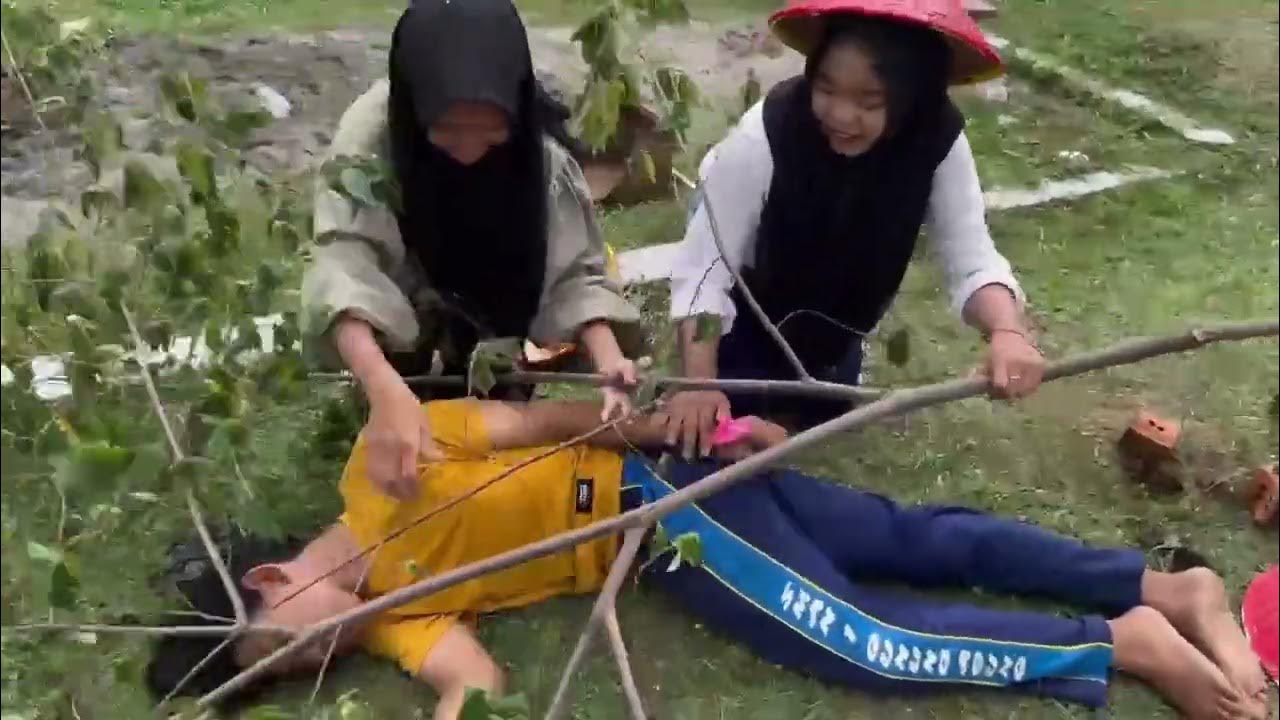Project DINA: Tsunami
Summary
TLDRThe video script emphasizes the inevitability of natural disasters in the Philippines and introduces Project Dina, an initiative aimed at disaster awareness and preparedness. It discusses the formation and dangers of tsunamis, highlighting the importance of early warning systems, evacuation plans, and community drills. The script advises planting trees and mangroves, installing warning signs, and ensuring clear escape routes. It also outlines three natural signs of an impending local tsunami: strong earthquakes, sudden water level changes, and unusual ocean behavior. The message concludes with a call for preparedness and safety, urging viewers to be ready to protect themselves and their families.
Takeaways
- 🌪️ Natural disasters like typhoons, volcanic eruptions, earthquakes, and fires are inevitable but can be managed with proper preparedness.
- 📢 Project Dina aims to raise nationwide awareness about disasters by providing information and guidance on what to do during such events.
- 💡 The project encourages communities to be prepared and to work together to ensure the safety of families and communities.
- 🌊 A tsunami is a series of ocean waves caused by underwater earthquakes, landslides, volcanic eruptions, or underwater collapses.
- 🏞️ To mitigate tsunami effects, planting trees and mangroves along the coastline, and setting up warning signs near the shore are recommended.
- 🚨 Communities should establish tsunami evacuation plans and conduct drills to be prepared for such events.
- 🏁 There are three natural signs of an approaching local tsunami: a strong earthquake, sudden water level drop or rise, and a roaring sound of an approaching tsunami.
- 🏋️♂️ During a tsunami, residents should evacuate to higher ground, avoid going near the shore, and wait for an all-clear signal before returning.
- 🧳 After an earthquake, head to a safe evacuation area with an emergency survival bag and check on yourself and your companions.
- ⚓️ Tsunamis can be extremely dangerous, capable of overturning boats and moving large rocks and heavy objects, so following guidelines is crucial for protection.
Q & A
What is the purpose of Project Dina?
-Project Dina aims to provide nationwide awareness about disasters, such as typhoons, volcanic eruptions, and earthquakes, by giving sufficient information on what to do to prepare for these calamities and ensure the safety of families and communities.
What causes a tsunami?
-A tsunami is caused by underwater disturbances such as earthquakes with epicenters under the sea, landslides beneath the ocean, volcanic eruptions near or under the sea, or the collapse of large underwater masses.
How fast can a tsunami travel in deep water?
-A tsunami can travel at speeds of up to 800 km per hour in deep water.
What is the typical height of a tsunami wave near the shore?
-As a tsunami approaches the shore, its wave height can increase significantly, sometimes reaching over 10 meters or higher than a three-story building.
What measures can be taken to mitigate the effects of a tsunami?
-To mitigate tsunami effects, planting trees and mangroves along the coastline, installing warning signs near the shore, and ensuring clear and safe evacuation routes to higher ground are recommended.
What are the three natural signs of an approaching local tsunami?
-The three natural signs of an approaching local tsunami are: 1) a strong earthquake that can be felt, 2) a sudden drop or rise in sea level that is unusual compared to normal low or high tides, and 3) a roaring sound as the tsunami approaches.
What should people do when they feel the ground shaking during a tsunami?
-When the ground shakes, indicating a possible tsunami, people should immediately move to higher ground and take an emergency survival bag to the evacuation area.
Why is it important to follow evacuation drills during a tsunami?
-Following evacuation drills is crucial as it ensures that people know the safest and quickest routes to higher ground and can act quickly to save lives when a tsunami occurs.
What should people do after an earthquake to prepare for a potential tsunami?
-After an earthquake, people should head to higher ground, bring an emergency survival bag, and wait for an all-clear signal before returning to the coastal area.
How can communities be better prepared for disasters like tsunamis?
-Communities can be better prepared for disasters by having a comprehensive disaster plan, conducting regular drills, and educating residents about the signs of an impending tsunami and the importance of immediate action.
What is the significance of the phrase 'Be prepared, be safe, be vigilant' in the context of the script?
-The phrase 'Be prepared, be safe, be vigilant' emphasizes the importance of readiness, safety, and constant awareness in disaster-prone areas to protect oneself and one's family.
Outlines

هذا القسم متوفر فقط للمشتركين. يرجى الترقية للوصول إلى هذه الميزة.
قم بالترقية الآنMindmap

هذا القسم متوفر فقط للمشتركين. يرجى الترقية للوصول إلى هذه الميزة.
قم بالترقية الآنKeywords

هذا القسم متوفر فقط للمشتركين. يرجى الترقية للوصول إلى هذه الميزة.
قم بالترقية الآنHighlights

هذا القسم متوفر فقط للمشتركين. يرجى الترقية للوصول إلى هذه الميزة.
قم بالترقية الآنTranscripts

هذا القسم متوفر فقط للمشتركين. يرجى الترقية للوصول إلى هذه الميزة.
قم بالترقية الآنتصفح المزيد من مقاطع الفيديو ذات الصلة
5.0 / 5 (0 votes)






